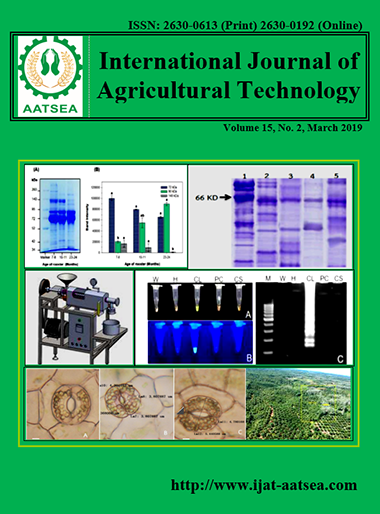Virulence and genetics at the molecular level of an indigenous strain of Beauveria bassiana affected by artificial and mass production media usage for sustainable insect control
Main Article Content
Abstract
Molecular biology of indigenous strain of entomopathogenic fungus, Beauveria bassiana (Balsamo) Vuillenim (Ascomycota: Hypocreales) (strain Bbs01) based on DNA fingerprinting and enzymatic studies and based on respective RAPD-PCR and acrylamide gel electrophoresis were conducted. The results showed that neither artificial media (PDA, SDA, SDAY, MEA, NA and WA) nor mass production material (cooked rice, paddy, millet and dog feed) effect the fungal genetic stability and protease enzyme activity. Correlation analysis indicated that pathogenicity of Bbs01 to cabbage aphids, Lipaphis erysimi (Hemiptera: Aphididae) and flea beetle, Phyllotreta sinuata (Coleoptera: Chrysomelidae) were increased with protease activity. Accordingly, the most suitable respective artificial and culture material for B. bassiana Bbs01were SDAY and dog food.
Article Details

This work is licensed under a Creative Commons Attribution-NonCommercial-NoDerivatives 4.0 International License.
References
Abbott, W. S. (1925). A method for computing the effectiveness of an insecticide. Journal of Economic Entomology. 18:265-267.
Alves, S. B., Rossi, L. S., Lopes, R. B., Tamai, M. A. and Pereira, R. M. (2002). Beauveria bassiana yeast phase on agar medium and its pathogenicity against Diatraea saccharalis (Lepidoptera: Crambidae) and Tetranychus urticae (Acari: Tetranychidae). Journal of Invertebrate Pathology. 81:70-77.
Butt, T. M., Jackson, C. W. and Magan, N. (2001). Fungi as biocontrol agents: progress, problems and potential. England, CABI.
Castrillo, L. A., Vandenberg, J. D. and Wraight S. P. (2003). Strain specific detection of introduced Beauveria bassiana in agricultural fields by use of sequence – characterized amplified region markers. Journal of Invertebrate Pathology. 82:75-83.
Copping, L. G. (2009). The manual of biocontrol agents (4th ed.). England, BCPC.
Fan, Y., Fang, W., Guo, S., Pei, X., Zhang, Y., Xiao, Y., Li, D., Jin, K., Bidochka, M. J. and Pei, Y. (2007). Increased insect virulence in Beauveria bassiana strains overexpressing an engineered chitinase. Applied and Environmental Microbiology. 73:295-302.
Inglis, D. G., Goettel, M. S., Butt, T. M. and Strasser, H. (2001). Use of Hyphomyecete fungi for managing insect pests. In: Butt, T.M., Jackson, C.W. and Magan, N. (Eds.). Fungi as Biocontrol Agents-Progress Problems and Potential. England. CABI. pp. 23-69.
Kucera, M. (1971). Toxins of the entomophagous fungus Beauveria bassiana. II. Effect of nitrogen sources on formation of the toxic protease in submerged culture. Journal of Invertebrate Pathology. 17:211-215.
Kunitz, M. C. (1947). Soybean Trypsin Inhibitor, II. General properties. Journal of General Physiology. 30:291-310.
Lacey, L. A. (1997). Biological control techniques: Manual of techniques in insect pathology. CA, Academic Press.
Lewis, L. C., Berry, E. C. and Bing, K. G. (1996). Aptness of insecticides (Bacillus thuringiensis and carbofuran) with endophytic Beauveria bassiana (Balsamo) Vuillemin for European corn borer control program for immediate and season-long suppression. Canadian Entomologist. 123:387-393.
Le Clerg, E. L., Leonard, W. H. and Clark, A. G. (1966). Field plot technique (2nd ed.). MN, Burgess.
Lopez, L., Carbonell, L.V. and Salinas, J. (1999). Colonization of plant waste substrates by entomopathogenic and mycoparasitic fungi - a SEM study. Micron. 3:325-333.
Maurer, P., Couteaudier, Y., Girard, P. A., Bridge, P. D. and Riba, G. (1997). Genetic diversity of Beauveria bassiana and relatedness to host insect range. Mycological Research. 101:159-164.
Posada-Florez, F. J. (2008). Production of Beauveria bassiana fungal spores on rice to control the coffee berry borer, Hypothenemus hampei, in Colombia. Journal of Insect Science. 8:1-13.
Rodríguez-Gómez, Loera, D. O., Saucedo-Castañeda, G. and Viniegra-González, G. (2009). Substrate influence on physiology and virulence of Beauveria bassiana acting on larvae and adults of Tenebrio molitor. Microbiology and Biotechnology. 25:513-518.
Snedecor, G. W. and Cochran, W. G. (1967). Statistical methods. IA, Iowa State University.
Saengyot, S. and Napompeth, B. (2007). Simple technique for mass propagation of Bueaveria bassiana for biological control in Thailand. Journal of International Society of Southeast Asian Agricultural Sciences, supplement. pp. 1-7.
Sahayaraj, K. and Namasivayam, S. K. R. (2008). Mass production of entomopathogenic fungi using agricultural products and by- products. African Journal of Biotechnology. 7: 1907-1910.
Tanada, Y. and Kaya, H. K. (1993). Insect pathology. CA, Academic Press.
Wadley, F. M. (1967). Experimental statistics in entomology. U.S. Department of Agriculture. Washington DC, Graduate School Press.
Zhang, Y., Zhao, J., Fang, W., Zhang, J., Luo, Z., Zhang, M., Fan, Y. and Pei, Y. (2009). Nitrogen-activated protein kinase hog1 in the entomopathogenic fungus Beauveria bassiana regulates environmental stress responses and virulence to insects. Applied and Environmental Microbiology. 75:787-795.


